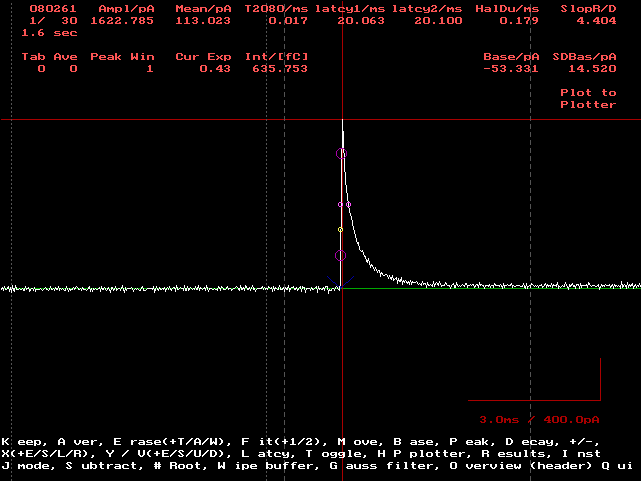Preface¶
| Author: | Christoph Schmidt-Hieber (christsc at gmx.de) |
|---|---|
| Date: | 20 February, 2019 |
Stimfit was originally written by Peter Jonas, University of Freiburg,
in the early 1990s. It was primarily designed to analyze the kinetics of
evoked excitatory postsynaptic potentials (EPSCs; Jonas et al., 1993 [1]).
The name Stimfit was chosen because the program allowed to fit
exponential functions to the decay of EPSCs evoked by extracellular
stim-ulation. The program was written in Borland Pascal, running under
DOS and entirely controlled using keyboards shortcuts. The user
interface was similar to a digital oscilloscope, with vertical cursors
defining measurement windows for baseline calculation, peak detection
and curve fitting. This allowed to analyze data with surprising
efficiency once the keyboard shortcuts were mastered. However, the
Borland Pascal compiler imposed some significant restrictions which
became apparent with increasing data size and computing power: for
instance, arrays were not allowed to be longer than  elements, and
faster processors had to be artificially slowed down to avoid runtime
errors.
elements, and
faster processors had to be artificially slowed down to avoid runtime
errors.

Stimfit running on GNU/Linux

The original Stimfit for MS-DOS.
When I converted the original Pascal program to C/C++, I rewrote the code almost entirely from scratch. Only the algorithms to calculate latencies, rise times, half durations and slopes are direct translations of the original Pascal code. By contrast, I tried to preserve the user interface as far as possible. Therefore, the program only poorly adheres to common conventions for graphical user interfaces: for instance, clicking the right mouse button will usually set a cursor position rather than popping up a context menu.
A number of people have contributed to the program: First, I would like to thank Peter Jonas for the original Stimfit code. Josef Bischofberger has added some functions to the DOS version which I have adopted. Bill Anderson has made helpful suggestions concerning the user interface and provided some very large files that have been recorded with his free program WinLTP. A large amount of helpful comments and bug reports were filed by Emmanuel Eggermann and Daniel Boischer. The Levenberg-Marquardt algorithm used for curve fitting was implemented by Manolis Lourakis.
| [1] | Jonas P, Major G, Sakman B. (1993) Quantal components of unitary EPSCs at the mossy fibre synapse on CA3 pyramidal cells of rat hippocampus. J Physiol. 472, 615-63. |
